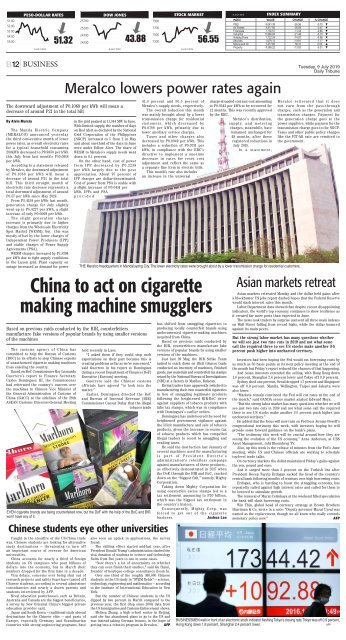DT_20190709
You also want an ePaper? Increase the reach of your titles
YUMPU automatically turns print PDFs into web optimized ePapers that Google loves.
51.00<br />
52.00<br />
53.00<br />
54.00<br />
55.00<br />
PESO-DOLLAR RATES<br />
8 JULY 2019<br />
51.32<br />
25700<br />
25200<br />
24700<br />
24200<br />
DOW JONES<br />
8 JULY 2019<br />
43.88<br />
7900<br />
7700<br />
STOCK MARKET<br />
7500<br />
7300 56.55<br />
8 JULY 2019<br />
8 JULY 2019<br />
INDEX SUMMARY<br />
INDEX VALUE CHANGE % CHANGE<br />
PSEi 8,061.39 -55.56 -0.70 ▼<br />
All Shares 4,917.60 -28.08 -0.57 ▼<br />
Financials 1,730.57 -11.44 -0.66 ▼<br />
Industrial 11,966.84 -21.48 -0.18 ▼<br />
Holding Firms 7,722.24 -74.97 -0.96 ▼<br />
Services 1,679.13 -19.91 -1.17 ▼<br />
Mining and Oil 7,477.60 38.31 0.52 ▲<br />
Property 4,366.22 -13.53 -0.31 ▼<br />
B12 BUSINESS<br />
Tuesday, 9 July 2019<br />
Daily Tribune<br />
The downward adjustment of P0.1068 per kWh will mean a<br />
decrease of around P21 in the total bill<br />
By Alvin Murcia<br />
The Manila Electric Company<br />
(MERALCO) announced yesterday<br />
the third consecutive month of lower<br />
power rates, as overall electricity rates<br />
for a typical household consuming<br />
200kWh decreased to P9.9850 per kWh<br />
this July from last month’s P10.0918<br />
per kWh.<br />
According to a statement released<br />
by Meralco, the downward adjustment<br />
of P0.1068 per kWh will mean a<br />
decrease of around P21 in the total<br />
bill. This third straight month of<br />
electricity rate decrease represents a<br />
total downward adjustment of around<br />
P0.57 per kWh since May 2019.<br />
From P5.4158 per kWh last month,<br />
generation charge for July slightly<br />
went up to P5.4227 per kWh, a slight<br />
increase of only P0.0069 per kWh.<br />
The slight generation charge<br />
increase is primarily due to higher<br />
charges from the Wholesale Electricity<br />
Spot Market (WESM), but this was<br />
mostly offset by the lower charges of<br />
Independent Power Producers (IPP)<br />
and stable charges of Power Supply<br />
Agreements (PSA).<br />
WESM charges increased by P1.8794<br />
per kWh due to tight supply conditions<br />
in the Luzon grid. Plant capacity on<br />
outage increased as demand for power<br />
Meralco lowers power rates again<br />
in the grid peaked at 11,344 MW in June.<br />
With limited supply, the number of days<br />
on Red Alert as declared by the National<br />
Grid Corporation of the Philippines<br />
(NGCP) increased to 5 from 2 in May<br />
and about one-third of the days in June<br />
were under Yellow Alert. The share of<br />
WESM to Meralco’s supply needs went<br />
down to 8.1 percent.<br />
On the other hand, cost of power<br />
from IPP decreased by P0.2239<br />
per kWh largely due to the peso<br />
appreciation. About 97 percent of<br />
IPP charges are dollar-denominated.<br />
Cost of power from PSA is stable with<br />
a slight increase of P0.0414 per<br />
kWh. IPPs and PSA<br />
provided<br />
41.4 percent and 50.5 percent of<br />
Meralco’s supply needs, respectively.<br />
The overall reduction this month<br />
was mainly brought about by a lower<br />
transmission charge for residential<br />
customers, which decreased by<br />
P0.0788 per kWh, primarily due to<br />
lower ancillary service charges.<br />
Taxes and other charges also<br />
decreased by P0.0349 per kWh. This<br />
includes a reduction of P0.0731 per<br />
kWh, in compliance with the ERC’s<br />
directive to implement a one-time<br />
decrease in rates for reset cost<br />
adjustment and reflect the same as<br />
a separate line item in electric bills.<br />
This month’s rate also includes<br />
an increase in the universal<br />
China to act on cigarette<br />
making machine smugglers<br />
Based on previous raids conducted by the BIR, counterfeiters<br />
manufacture fake versions of popular brands by using smaller versions<br />
of the machines<br />
The customs agency of China has<br />
committed to help the Bureau of Customs<br />
(BOC) in its efforts to stop Chinese exports<br />
of unauthorized cigarette making machines<br />
from entering the country.<br />
Based on BoC Commissioner Rey Leonardo<br />
Guerrero’s report to Finance Secretary<br />
Carlos Dominguez III, the Commissioner<br />
had reiterated the country’s concern over<br />
the machines to Chinese Vice Minister of<br />
the General Administration of Customs of<br />
China (GACC) at the sidelines of the 28th<br />
ASEAN Customs Directors-General Meeting<br />
held recently in Laos.<br />
“I asked them if they could stop such<br />
exportations on their part because this is<br />
creating problems as far as we’re concerned,”<br />
said Guerrero in his report to Dominguez<br />
during a recent Department of Finance (DoF)<br />
Executive (Execom) meeting.<br />
Guerrero said the Chinese customs<br />
officials have agreed “to look into the<br />
matter.”<br />
Earlier, Dominguez directed the BoC<br />
and Bureau of Internal Revenue (BIR)<br />
Commissioner Caesar Dulay that the illegal<br />
tobacco trade<br />
EVEN cigarette brands are being counterfeited now, but the DoF with the help of the BoC and BIR,<br />
won’t have any of it.<br />
Caught in the crossfire of the US-China trade<br />
war, Chinese students are looking for alternative<br />
study destinations — threatening to turn off<br />
an important source of revenue for American<br />
universities.<br />
China accounts for nearly a third of foreign<br />
students on US campuses who pour billions of<br />
dollars into the economy, but in March their<br />
numbers dropped for the first time in a decade.<br />
Visa delays, concerns over being shut out of<br />
research projects and safety fears have turned off<br />
Chinese students, according to several admissions<br />
consultancies and nearly a dozen parents and<br />
students interviewed by AFP.<br />
Rival education powerhouses such as Britain,<br />
Australia and Canada are the biggest beneficiaries,<br />
a survey by New Oriental China’s biggest private<br />
education provider said.<br />
Japan and South Korea — traditional study abroad<br />
destinations for the Chinese elite — and parts of<br />
Europe, especially Germany and Scandinavian<br />
countries with strong engineering programs, have<br />
also seen an uptick in applications, the survey<br />
found.<br />
The chilling effect started mid-last year, after<br />
President Donald Trump’s administration slashed the<br />
visa duration of students in science and technology<br />
fields from five years to one in some cases.<br />
“Now there’s a lot of uncertainty on whether<br />
they can even finish their studies,” said Gu Huini,<br />
founder of boutique college consultancy Zoom In.<br />
Over one third of the roughly 360,000 Chinese<br />
students in the US study in “STEM fields” — science,<br />
technology, engineering and mathematics — according<br />
to the Institute of International Education in New<br />
York.<br />
But the number of Chinese students in the US<br />
dipped by two percent in March compared to the<br />
previous year, the first drop since 2009, data from<br />
the US Immigration and Customs Enforcement shows.<br />
Melissa Zhang, a high school senior in Beijing,<br />
said she has abandoned plans to go to the US and<br />
was instead taking German lessons, in the hope of<br />
getting into a robotics program in Dresden. AFP<br />
has shifted from smuggling cigarettes to<br />
producing locally counterfeit brands using<br />
undocumented cigarette-making machines<br />
acquired from China.<br />
Based on previous raids conducted by<br />
the BIR, counterfeiters manufacture fake<br />
versions of popular brands by using smaller<br />
versions of the machines.<br />
Just last 29 May, the BIR Strike Team<br />
tasked to crack down on illicit tobacco trade<br />
conducted an inventory of machines, finished<br />
goods, raw materials and counterfeit tax stamps<br />
seized by the National Bureau of Investigations<br />
(NBI) at a factory in Marilao, Bulacan.<br />
Erring traders have apparently switched to<br />
manufacturing their own counterfeit cigarettes<br />
in lieu of smuggling legitimate products<br />
following the heightened BIR-BoC drive<br />
against suppliers of tobacco products with<br />
fake tax stamps, which was in compliance<br />
with Dominguez’s earlier orders.<br />
Dominguez has underscored the need for<br />
heightened government vigilance against<br />
the illicit manufacture and sale of tobacco<br />
products, given the increase in excise tax<br />
of tobacco products which has compelled<br />
illegal traders to resort to smuggling and<br />
evading taxes.<br />
He said the destruction last January of<br />
several machines used for manufacturing<br />
is part of President Duterte’s<br />
administration’s relentless campaign<br />
against manufacturers of these products.,<br />
as effectively demonstrated in 2017 when<br />
the DoF, through the BIR and BoC, cracked<br />
down on the “biggest fish,” namely, Mighty<br />
Corporation.<br />
Taking down Mighty Corporation for<br />
using counterfeit excise stamps led to a<br />
tax settlement amounting to P30 billion,<br />
which was the biggest tax settlement in<br />
the country’s history.<br />
Consequently, Mighty Corp. was<br />
forced to get out of the cigarette<br />
business.<br />
Joshua Lao<br />
charge-stranded contract cost amounting<br />
to P0.0543 per kWh to be recovered for<br />
12 months. This was recently approved<br />
by the ERC.<br />
Meralco’s distribution,<br />
supply, and metering<br />
charges, meanwhile, have<br />
remained unchanged for<br />
48 months, after these<br />
registered reductions in<br />
July 2015.<br />
In a statement,<br />
THE Meralco headquarters in Mandaluyong City. The lower electricity rates were brought about by a lower transmission charge for residential customers.<br />
Chinese students eye other universities<br />
Meralco reiterated that it does<br />
not earn from the pass-through<br />
charges, such as the generation and<br />
transmission charges. Payment for<br />
the generation charge goes to the<br />
power suppliers, while paymen for the<br />
transmission charge goes to the NGCP.<br />
Taxes and other public policy charges<br />
like the FIT-All rate are remitted to<br />
the government.<br />
Asian markets retreat<br />
Asian markets retreated Monday and the dollar held gains after<br />
a blockbuster US jobs report dashed hopes that the Federal Reserve<br />
would slash interest rates this month.<br />
Labor Department data showed that despite recent disappointing<br />
indicators, the world’s top economy continues to show resilience as<br />
it created far more posts than expected in June.<br />
The news took traders by surprise and sent all three main indexes<br />
on Wall Street falling from record highs, while the dollar bounced<br />
against its main peers.<br />
But the strong labor market has many questions whether<br />
we will see just two rate cuts in 2019 and not what some<br />
call the required three to see US stocks make another 3-5<br />
percent push higher into uncharted territory.<br />
Investors had been hoping the Fed would cut borrowing costs by<br />
as much as 50 basis points at its next policy meeting at the end of<br />
the month but Friday’s report reduced the chances of that happening.<br />
And Asian investors extended the selling, with Hong Kong down<br />
1.8 percent, Shanghai 2.4 percent lower and Tokyo off 0.9 percent.<br />
Sydney shed one percent, Seoul dropped 1.7 percent and Singapore<br />
was off 0.9 percent. Manila, Wellington, Taipei and Jakarta were<br />
also lower.<br />
“Markets remain convinced the Fed will cut rates at the end of<br />
the month,” said OANDA senior market analyst Edward Moya.<br />
“But the strong labor market has many questions whether we will<br />
see just two rate cuts in 2019 and not what some call the required<br />
three to see US stocks make another 3-5 percent push higher into<br />
uncharted territory.”<br />
He added that the focus will now turn on Fed boss Jerome Powell’s<br />
congressional testimony this week, with investors hoping he will<br />
provide some forward guidance on the bank’s plans.<br />
“The testimony this week will be crucial around how they are<br />
seeing the evolution of the US economy,” Anne Anderson, at UBS<br />
Asset Management, told Bloomberg TV.<br />
Also, up this week is the release of minutes from the Fed’s June<br />
meeting, while US and Chinese officials are working to schedule<br />
top-level trade talks.<br />
On currency markets the dollar-maintained Friday’s gains against<br />
the yen, pound and euro.<br />
And it surged more than 3 percent on the Turkish lira after<br />
President Recep Tayyip Erdogan sacked the head of the country’s<br />
central bank following months of tensions over high borrowing costs.<br />
Erdogan, who is battling to boost the struggling economy, has<br />
repeatedly railed against high interest rates and called for them to<br />
be lowered to stimulate growth.<br />
The removal of Murat Cetinkaya at the weekend filled speculation<br />
the bank will slash borrowing costs.<br />
Win Thin, global head of currency strategy at Brown Brothers<br />
Harriman & Co, wrote in a note: “Deputy governor Murat Uysal was<br />
named as the replacement, though we all know who really controls<br />
monetary policy now.”<br />
AFP<br />
BUSINESSMEN walk in front of an electronic stock indicator flashing Tokyo’s closing rate. Tokyo was off 0.9 percent,<br />
Hong Kong down 1.8 percent, Shanghai 2.4 percent lower.<br />
AFP


















